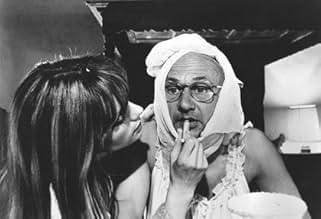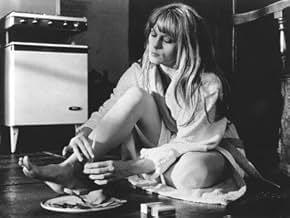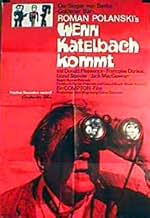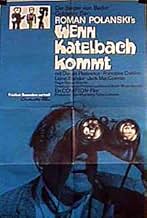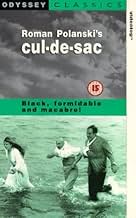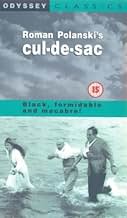Cul-de-sac
- 1966
- Tous publics
- 1h 52m
IMDb RATING
7.0/10
15K
YOUR RATING
In search of help, two wounded gangsters on the run find refuge in the secluded castle of a feeble man and his wife; however, under the point of a gun, nothing is what it seems.In search of help, two wounded gangsters on the run find refuge in the secluded castle of a feeble man and his wife; however, under the point of a gun, nothing is what it seems.In search of help, two wounded gangsters on the run find refuge in the secluded castle of a feeble man and his wife; however, under the point of a gun, nothing is what it seems.
- Director
- Writers
- Stars
- Nominated for 1 BAFTA Award
- 1 win & 1 nomination total
Jacqueline Bisset
- Jacqueline
- (as Jackie Bisset)
- Director
- Writers
- All cast & crew
- Production, box office & more at IMDbPro
Featured reviews
After their car becomes stuck on a causeway, two gangsters named Dickey and Albie find themselves stranded on the remote island of Lindisfarne. There, they take refuge in a castle owned by an eccentric couple, the mentally unbalanced George and his promiscuous and beautiful wife Teresa. The hoods proceed to hold George and Teresa hostage, until their boss Katelbach can send them some transportation off the rock. However, matters become complicated by the arrival of a group of George's friends, one of whom Teresa has an affair with. So begins 'Cul-de-sac,' a tale of madness, sexual frustration and pitch-black comedy that could only have come from the mind of Roman Polanski.
Original, abstract and frequently funny, Polanski's 'Cul-de-sac' is a fascinating, captivating movie that will delight any fan of the dark and strange. Much like his earlier 'Repulsion,' the film launches the viewer into a weird world populated by odd folk struggling with their desires and how to interact with the people around them. The characters engage in a power struggle throughout the film, with manipulation and thuggery being the prime weapons at their disposal. While the hoodlums take George and Teresa hostage, it is also Teresa who makes George a hostage of her lust, and it is she who does the most damage to his psyche.
It is a film that will likely spark differing opinions as to what the meaning of it all is. Some cinema-goers enjoy the guesswork, though others find abstractions infuriating; and 'Cul-de-sac' is not for the impatient or the shunners of philosophy. It's an intriguing, dark thriller that also happens to be one of Polanski's funniest outings, as he injects the narrative with much off-beat humor and sharp, banterous dialogue. The film still features his trademark examinations of paranoia, isolation and social unease; though told in a slightly lighter fashion than one accustomed to Polanski would expect (which, for this viewer anyway, comes as a boon to the proceedings).
'Cul-de-sac' is a visually enthralling flick, featuring arresting cinematography from Gilbert Taylor, who lent his talents to the previous 'Repulsion,' and would go on to work with Polanski once more on 'MacBeth.' Their collaborations made for undeniably artistic and powerful visuals that intrigue and impress, both in creative and technical terms. 'Cul-de-sac' boasts some incredible cinematography, from intense tracking shots to the masterful manipulation of light and shadows; Taylor's distinct and evocative work under Polanski's firm direction is unforgettable.
Alastair McIntyre was a frequent collaborator of Polanski's, and his editing for 'Cul-de-sac' is swift and smart. Reportedly, the two men toiled very closely together in the editing suite, developing over the years an intuitive and fruitful working relationship build on mutual respect and admiration. Looking at the remarkably tight, streamlined final cut of 'Cul-de-sac;' it's easy to see why Polanski utilized McIntyre on six films- his work is nigh on flawless.
Also of note is the score from Krzysztof Komeda, which is jazzy and strangely haunting; like elevator music from Dante's second circle of hell. His melodies fit perfectly the images of the film, as odd and as unsettling as some of them may be. Additionally, Bridget Sellers' rich costume design and George Lack's detailed set decoration and art direction lends the film additional impact and depth to the locales and characters.
'Cul-de-sac' stars Donald Pleasence as George, Françoise Dorléac as Teresa and Lionel Stander as Dickey, with the three of them turning in strong performances that are highlights in each of their filmographies. Pleasence is terrific as the unhinged, deeply neurotic George, imbuing him with an almost childlike quality which makes the character all the more interesting and odd. Though sometimes in films Pleasence had a tendency to go a little over-the-top, here he remains grounded, despite the weirdness of the role; doing consummate work that is hard to forget.
Dorléac- who tragically died before making it as big internationally as her sister Catherine Deneuve- is nothing short of a sensation as Teresa, giving a performance of wit, intelligence and depth that is a real treat to watch. As wily and as seductive as a panther in the night, Dorléac is not afraid to make Teresa unlikable, though she remains charismatic throughout. From her all too short career in film, Dorléac's assured performance in 'Cul-de-sac' is her greatest and most compelling.
Finally, Lionel Stander is brilliant as Dickey, the humorous hoodlum who takes hostage and tries to manipulate George and Teresa. Stander was a talented actor whose screen presence- like Ernest Borgnine- was such that you'd warm to him no matter what he did, evil or nay. With his crooked grin and gravelly voice, he leaves an indelible impression on the viewer; making Dickey a character that is most memorable. The supporting cast all perform admirably too, with a young Jacqueline Bisset and Jack MacGowran impressing the most.
Roman Polanski's 'Cul-de-sac' is a powerful and off-beat thriller that has a lot to offer viewers. Featuring an atmospheric Krzysztof Komeda score, stunning visuals from Gilbert Taylor and a cast performing at the top of their games; there is very little not to praise about the movie. If you enjoy films of abstractions and you have not seen it before, it is advisable that you do so now; as 'Cul-de-sac' is a weird, wild and wonderful movie that is not to be missed.
Original, abstract and frequently funny, Polanski's 'Cul-de-sac' is a fascinating, captivating movie that will delight any fan of the dark and strange. Much like his earlier 'Repulsion,' the film launches the viewer into a weird world populated by odd folk struggling with their desires and how to interact with the people around them. The characters engage in a power struggle throughout the film, with manipulation and thuggery being the prime weapons at their disposal. While the hoodlums take George and Teresa hostage, it is also Teresa who makes George a hostage of her lust, and it is she who does the most damage to his psyche.
It is a film that will likely spark differing opinions as to what the meaning of it all is. Some cinema-goers enjoy the guesswork, though others find abstractions infuriating; and 'Cul-de-sac' is not for the impatient or the shunners of philosophy. It's an intriguing, dark thriller that also happens to be one of Polanski's funniest outings, as he injects the narrative with much off-beat humor and sharp, banterous dialogue. The film still features his trademark examinations of paranoia, isolation and social unease; though told in a slightly lighter fashion than one accustomed to Polanski would expect (which, for this viewer anyway, comes as a boon to the proceedings).
'Cul-de-sac' is a visually enthralling flick, featuring arresting cinematography from Gilbert Taylor, who lent his talents to the previous 'Repulsion,' and would go on to work with Polanski once more on 'MacBeth.' Their collaborations made for undeniably artistic and powerful visuals that intrigue and impress, both in creative and technical terms. 'Cul-de-sac' boasts some incredible cinematography, from intense tracking shots to the masterful manipulation of light and shadows; Taylor's distinct and evocative work under Polanski's firm direction is unforgettable.
Alastair McIntyre was a frequent collaborator of Polanski's, and his editing for 'Cul-de-sac' is swift and smart. Reportedly, the two men toiled very closely together in the editing suite, developing over the years an intuitive and fruitful working relationship build on mutual respect and admiration. Looking at the remarkably tight, streamlined final cut of 'Cul-de-sac;' it's easy to see why Polanski utilized McIntyre on six films- his work is nigh on flawless.
Also of note is the score from Krzysztof Komeda, which is jazzy and strangely haunting; like elevator music from Dante's second circle of hell. His melodies fit perfectly the images of the film, as odd and as unsettling as some of them may be. Additionally, Bridget Sellers' rich costume design and George Lack's detailed set decoration and art direction lends the film additional impact and depth to the locales and characters.
'Cul-de-sac' stars Donald Pleasence as George, Françoise Dorléac as Teresa and Lionel Stander as Dickey, with the three of them turning in strong performances that are highlights in each of their filmographies. Pleasence is terrific as the unhinged, deeply neurotic George, imbuing him with an almost childlike quality which makes the character all the more interesting and odd. Though sometimes in films Pleasence had a tendency to go a little over-the-top, here he remains grounded, despite the weirdness of the role; doing consummate work that is hard to forget.
Dorléac- who tragically died before making it as big internationally as her sister Catherine Deneuve- is nothing short of a sensation as Teresa, giving a performance of wit, intelligence and depth that is a real treat to watch. As wily and as seductive as a panther in the night, Dorléac is not afraid to make Teresa unlikable, though she remains charismatic throughout. From her all too short career in film, Dorléac's assured performance in 'Cul-de-sac' is her greatest and most compelling.
Finally, Lionel Stander is brilliant as Dickey, the humorous hoodlum who takes hostage and tries to manipulate George and Teresa. Stander was a talented actor whose screen presence- like Ernest Borgnine- was such that you'd warm to him no matter what he did, evil or nay. With his crooked grin and gravelly voice, he leaves an indelible impression on the viewer; making Dickey a character that is most memorable. The supporting cast all perform admirably too, with a young Jacqueline Bisset and Jack MacGowran impressing the most.
Roman Polanski's 'Cul-de-sac' is a powerful and off-beat thriller that has a lot to offer viewers. Featuring an atmospheric Krzysztof Komeda score, stunning visuals from Gilbert Taylor and a cast performing at the top of their games; there is very little not to praise about the movie. If you enjoy films of abstractions and you have not seen it before, it is advisable that you do so now; as 'Cul-de-sac' is a weird, wild and wonderful movie that is not to be missed.
This film is incredible. Polanski's best film behind Knife in the Water and Rosemary's Baby.
The plot revolves around a gangster (Lionel Stander) and his partner that seek refuge in a castle on a small island in England. The couple that inhabit the castle are played by the sublime Donald Pleasance and the beautiful Françoise Dorléac. The movie plays out like a three way triangle of hatred; we have the contempt between the couple and the gangster, who is invading their home; the gangster's mean streak is inflicted on the couple and the lady obviously holds her husband in low regard when he takes on the role of a wimp in front of the gun toting criminal. However, it is not as simple as that as in several points in the movie, the characters let their guard down and start to communicate with each other in an almost friendly way. This is the real beauty of this film; it is a character study, studying the relationship between a couple and a third party in their home. Three is a crowd, and the effects of that true to life phrase are felt by each of the three characters.
The three main players in Cul-De-Sac are fantastic, Lional Stander in particular who was surely born to play his role in this movie. He has the voice and the persona of a not very bright gangster spot on; his comic timing for some of his more obviously funny lines is also noteworthy. Donald Pleasance has never been better than he was here either; his portrayal as the 'lord of the manor' is both believable and intriguing. Last but not least, Françoise Dorléac, in undoubtedly the most overlooked role in the piece, although no less important than the other two, is also on time and believable in her role; making up a perfect cast.
From a relatively simple plot line and few characters, through excellent dialogue, restrained plotting and interesting scenarios, Roman Polanksi has managed to weave a story that is interesting and entertaining. Roman Polanski has a great flair for human relationships in his movies, the best example of this was in his best movie, Knife in the Water, and that element is abundant here too. The scenes in which all three characters are on screen interacting with each other are this movie's finest moments.
Cul-De-Sac is an excellent black comedy thriller that fans of the genre and fans of the excellent Roman Polanski will not want to miss. Recommended viewing
The plot revolves around a gangster (Lionel Stander) and his partner that seek refuge in a castle on a small island in England. The couple that inhabit the castle are played by the sublime Donald Pleasance and the beautiful Françoise Dorléac. The movie plays out like a three way triangle of hatred; we have the contempt between the couple and the gangster, who is invading their home; the gangster's mean streak is inflicted on the couple and the lady obviously holds her husband in low regard when he takes on the role of a wimp in front of the gun toting criminal. However, it is not as simple as that as in several points in the movie, the characters let their guard down and start to communicate with each other in an almost friendly way. This is the real beauty of this film; it is a character study, studying the relationship between a couple and a third party in their home. Three is a crowd, and the effects of that true to life phrase are felt by each of the three characters.
The three main players in Cul-De-Sac are fantastic, Lional Stander in particular who was surely born to play his role in this movie. He has the voice and the persona of a not very bright gangster spot on; his comic timing for some of his more obviously funny lines is also noteworthy. Donald Pleasance has never been better than he was here either; his portrayal as the 'lord of the manor' is both believable and intriguing. Last but not least, Françoise Dorléac, in undoubtedly the most overlooked role in the piece, although no less important than the other two, is also on time and believable in her role; making up a perfect cast.
From a relatively simple plot line and few characters, through excellent dialogue, restrained plotting and interesting scenarios, Roman Polanksi has managed to weave a story that is interesting and entertaining. Roman Polanski has a great flair for human relationships in his movies, the best example of this was in his best movie, Knife in the Water, and that element is abundant here too. The scenes in which all three characters are on screen interacting with each other are this movie's finest moments.
Cul-De-Sac is an excellent black comedy thriller that fans of the genre and fans of the excellent Roman Polanski will not want to miss. Recommended viewing
Captivatingly bizarre movie. Dickie and Albie, both injured and on-the-run following a failed heist, stumble upon effeminate George and promiscuous Teresa's secluded castle on the shore. Lionel Stander as the menacingly uncouth thug Dickie is the standout in the cast as he takes over the household while waiting for the gang boss to come and get him and his partner. Donald Pleasence and Franciose Dorleac as the invaded couple were also excellent as they deal with not only the crooks but an unwelcome family visit. Not for everybody but if you're in the mood for something unusual from the 60s or just wanting to view an example of early Polaski .
Cul-de-sac is a very beautiful black and white movie. It belongs to the lightweight category. The story is weird in an entertaining way, often amusing and sad at once. If the director tried to be willingly shallow, he was very successful. And I do not mean that ironically but say it with awe.
The place is Holy Island, on the east coast of Northern England. It actually gets cut off with the tide. Polanski makes very good use of the location and was very lucky with the casting. All characters are rather detestable in a detached sort of way. Donald Pleasance gives the performance of his life as the emasculated, utterly humiliated owner of the castle on the island. The other two main characters are the brisk yet elf like Françoise Dorléac and Lionel Stander as a gruff, brutal gangster. There is a very strange, truly unique chemistry between Dorléac and Stander. Dorléac does something to Stander. «We call dees a bicycle», she says gleefully with her funny accent, and it nearly knocks me off my chair every time I see that well filmed, suspenseful scene. I wont tell you what «de bicycle» is it may need parental guidance to watch it but does not belong to the restrictable area. Cul-de-sac has a very memorable musical score.
The place is Holy Island, on the east coast of Northern England. It actually gets cut off with the tide. Polanski makes very good use of the location and was very lucky with the casting. All characters are rather detestable in a detached sort of way. Donald Pleasance gives the performance of his life as the emasculated, utterly humiliated owner of the castle on the island. The other two main characters are the brisk yet elf like Françoise Dorléac and Lionel Stander as a gruff, brutal gangster. There is a very strange, truly unique chemistry between Dorléac and Stander. Dorléac does something to Stander. «We call dees a bicycle», she says gleefully with her funny accent, and it nearly knocks me off my chair every time I see that well filmed, suspenseful scene. I wont tell you what «de bicycle» is it may need parental guidance to watch it but does not belong to the restrictable area. Cul-de-sac has a very memorable musical score.
CUL-DE-SAC is a psychological comic thriller as an unusual set of surreal circumstances in a realistic landscape. The characters are trapped in a confusing context, which is made up of a mafia, art, promiscuity and perversions. The story is peppered with all sorts of antics, but it is not unpleasant. The plots are inconclusive, but its are enriched with a huge dose of black humor.
A neurotic and effeminate middle-aged Englishman named George lives with his promiscuous young French wife Teresa in a dark castle on a hilltop. Two gangsters, after the unexpected upward tide, invade their messy home and hold them as hostage. Teresa is mad at her timid husband, who does not take any action on the bandits. Gangsters are starting to behave a bit eccentric, while waiting for help from his boss. Uninvited guests come to a visit. Simply, someone has to "boil over"...
Mr. Polanski, in this film, covers topics such as the alienation and a latent madness, which are closely related to a sexual activity. He has managed to replace an emotional void in this film with a combination of black humor, crime and perversion. The characterization is not bad.
Donald Pleasence as George is a kinky and fun husband who has his grotesque moments in this film. He is a man who feels comfortable in a transparent nightgown but he, with a huge dose of disgust, takes a gun in his hand. That is a phenomenal paradox of the situation in the world. His cowardice is ambiguous, because, despite everything, he wants to return a harmonious relation in his home. Lionel Stander as Dickey, through his gangster attitude, distinctive voice and eccentric behavior enjoys the general madness. Françoise Dorléac as Teresa is a beautiful, attractive and nude factor of confusion between George and Dickey.
Mr. Polanski has skillfully managed to balance all segments in this film, but this story still reminds me to a sexy morbid joke.
A neurotic and effeminate middle-aged Englishman named George lives with his promiscuous young French wife Teresa in a dark castle on a hilltop. Two gangsters, after the unexpected upward tide, invade their messy home and hold them as hostage. Teresa is mad at her timid husband, who does not take any action on the bandits. Gangsters are starting to behave a bit eccentric, while waiting for help from his boss. Uninvited guests come to a visit. Simply, someone has to "boil over"...
Mr. Polanski, in this film, covers topics such as the alienation and a latent madness, which are closely related to a sexual activity. He has managed to replace an emotional void in this film with a combination of black humor, crime and perversion. The characterization is not bad.
Donald Pleasence as George is a kinky and fun husband who has his grotesque moments in this film. He is a man who feels comfortable in a transparent nightgown but he, with a huge dose of disgust, takes a gun in his hand. That is a phenomenal paradox of the situation in the world. His cowardice is ambiguous, because, despite everything, he wants to return a harmonious relation in his home. Lionel Stander as Dickey, through his gangster attitude, distinctive voice and eccentric behavior enjoys the general madness. Françoise Dorléac as Teresa is a beautiful, attractive and nude factor of confusion between George and Dickey.
Mr. Polanski has skillfully managed to balance all segments in this film, but this story still reminds me to a sexy morbid joke.
Did you know
- TriviaRoman Polanski shot 16 takes of the scene in which Lionel Stander drinks a pint of milk.
- GoofsWhen Dickie is pushing the car, the shadow of the camera and the cameraman can be seen on him.
- Alternate versionsThe VHS version released in Brazil by Globo Vídeo has exactly 100 minutes.
- ConnectionsFeatured in Le ciné-club de Radio-Canada: Film présenté: Cul-de-sac (1975)
Details
- Release date
- Country of origin
- Official site
- Language
- Also known as
- Ćorsokak
- Filming locations
- Production companies
- See more company credits at IMDbPro
Box office
- Gross worldwide
- $1,500
- Runtime
- 1h 52m(112 min)
- Color
- Aspect ratio
- 1.66 : 1
Contribute to this page
Suggest an edit or add missing content


